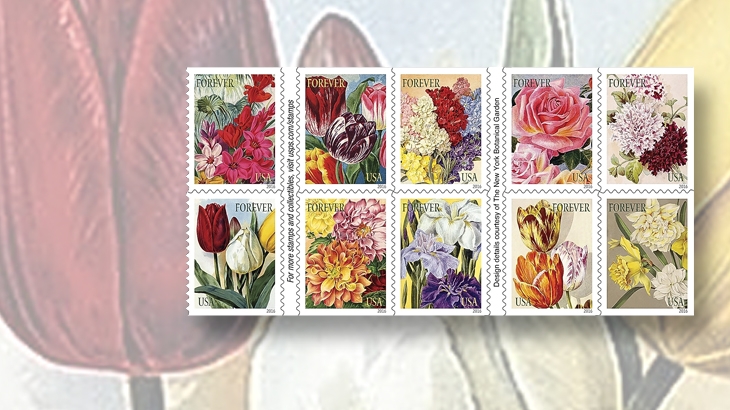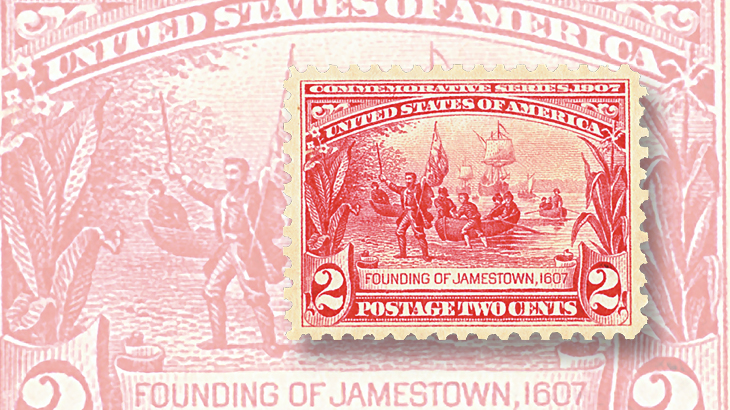US Stamps
Botanical Art stamps to debut at Ameristamp Expo
By Michael Baadke
Century-old paintings of flowers are prominently featured on 10 new United States Botanical Art stamps that will be issued Jan. 29 in panes of 10 and in double-sided panes of 20. The Postal Service identifies these formats as booklets.
The stamps will be introduced with a first-day ceremony at the American Philatelic Society’s annual winter stamp show, Ameristamp Expo 2016.
This year’s winter show is taking place at the downtown Hilton Atlanta, 255 Courtland St. NE, in Atlanta. The first-day ceremony will begin at 11 a.m. in the Crystal Ballroom. Admission is free, and the ceremony is open to the public.
According to the APS, Dawn Hamman of the American Topical Association will serve as master of ceremonies for the Botanical Art stamp event, with additional participants Mildred Pinnell Fockele of the Atlanta Botanical Garden, Scott English of the American Philatelic Society, Austin Foo of the APS Young Philatelic Leaders Fellowship, and Kristen Seaver of the United States Postal Service.
This stamp issue was designed by USPS art director Ethel Kessler using illustrations that were published in American nursery catalogs between 1891 and 1912.
“The design details are courtesy of The New York Botanical Garden,” said the Postal Service. “The catalogs are part of the NYBG’s Nursery and Seed Catalog Collection, one of the largest and most important collections in the U.S.”
The Postal Service has identified the flowers depicted on the stamps, from left to right on the top row, as corn lilies, tulips, stocks, roses, and petunias. The bottom row from left shows tulips; dahlias; Japanese iris; tulips; and, on the final stamp, a pairing of daffodils and jonquils.
“The issuance continues the Postal Service tradition of beautiful floral-themed stamps,” the USPS notes.
Botanical artwork has been part of United States stamps ever since the first issues in 1847. The frames around the 5¢ Benjamin Franklin and the 10¢ George Washington stamps (Scott 1-2) each have a background depicting a wreath of leaves.
The 2¢ stamp in the 1907 Jamestown Exposition set (Scott 329) features an actual flower, apparently sprouting from a tobacco plant. You can see it if you look carefully along the upper left side of the stamp, just left of the “U” in “UNITED STATES.”
A vase with flowers is featured in the 3¢ Mothers of America issue (Scott 737), which reproduces James A. Whistler’s portrait of his mother, commonly known as “Whistler’s Mother,” but formally titled An Arrangement in Grey and Black.
The stamp, however, is printed in purple, and the flowers — inexplicably added at some point during the development of the design — were never part of Whistler’s original painting.
From about the 1970s onward, flowers show up on U.S. stamps seemingly every few months; sometimes as a featured element, as on the 29¢ Garden Flowers booklet stamps issued in 1994 (Scott 2829-2833), and other times in less obvious ways, such as the ocotillos (Fouquieria splendens) on the 44¢ Nevada state flag stamp issued April 16, 2010 (Scott 4306).
Other than the Botanical Art stamps, the designs of the announced stamps for 2016 have relatively few flowers sprouting on them, though the background of the Madonna and Child painting planned for the 2016 Christmas stamp shows a pleasant mixture of pink and white blooms.
Press sheets of the Botanical Art stamps are being issued both with and without the die cuts that normally separate individual stamps.
Each press sheet contains 160 stamps, or eight of the 20-stamp double-sided panes, and sells for $78.40, the face value of the stamps on the sheet.
The Postal Service is making available 300 sheets with die cuts and 350 sheets without die cuts.
Technical details and first-day cancel ordering information for the Botanical Art forever stamps are presented below.
Nondenominated (49¢) Botanical Art forever stamps, panes of 10 and 20, convertible booklet format
FIRST DAY— Jan. 29, 2016; city— Atlanta, Ga., and nationwide.
DESIGN: artist— unknown, from existing catalog art (1891-1912); designer, art director and typographer— Ethel Kessler, Bethesda, Md.
PRINTING: process— offset; printer and processor— Ashton Potter, Williamsville, N.Y.; press— Muller A76; inks— yellow, magenta, cyan, black; paper— nonprephosphored type III, block tagging; gum— self-adhesive; issue quantity— 100 million stamps (pane of 10); 500 million stamps (pane of 20); format— pane of 10, convertible booklet format, from 520-subject cylinders; pane of 20, convertible booklet format, from 880-subject cylinders; size— 0.77 inches by 1.05 inches (image); 0.91 inches by 1.19 inches (overall); 1.82 inches by 6.37 inches (pane of 10); 5.76 inches by 2.38 inches (pane of 20); plate numbers— “P” followed by four single digits; marginal markings (pane of 10)— “Botanical Art,” “Ten First-Class Forever Stamps,” USPS logo, plate numbers in peel strip, “Design details courtesy of the New York Botanical Garden,” “© 2015 USPS,” purchasing information; marginal markings (pane of 20)— “Botanical Art,” “Twenty First-Class Forever Stamps,” USPS logo, plate numbers and promotional text in peel strip, “Design details courtesy of the New York Botanical Garden,” “© 2015 USPS”; USPS item Nos.— 678700 (pane of 10, convertible booklet format); 680600 (pane of 20, convertible booklet format).
First-day cancel ordering information
Standard ordering instructions apply. Collectors requesting first-day cancels are encouraged to purchase their own stamps and affix them to envelopes. The first-day cover envelopes should be addressed for return (a removable label may be used), and mailed in a larger envelope addressed to Botanical Art Stamps, Atlanta MPO, Postmaster, 3900 Crown Road, Atlanta, GA 30304-9998. Requests for first-day cancels must be postmarked by March 29.
The Postal Service’s uncacheted set of 10 first-day covers for the Botanical Art stamps is item No. 680616 at $9.30.
MORE RELATED ARTICLES
Headlines
-
World Stamps
Oct 10, 2024, 12 PMRoyal Mail honors 60 years of the Who
-
US Stamps
Oct 9, 2024, 3 PMProspectus available for Pipex 2025
-
US Stamps
Oct 9, 2024, 2 PMGratitude for Denise McCarty’s 43-year career with Linn’s
-
US Stamps
Oct 9, 2024, 12 PMWorld’s first butterfly topical stamp in strong demand







